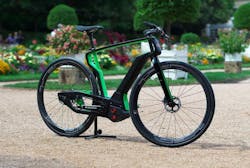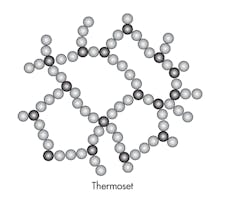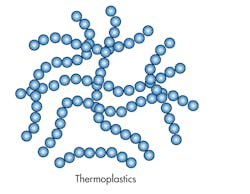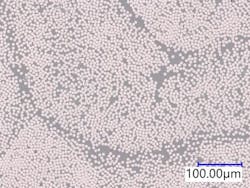The Benefits of Thermoplastics vs. Thermosets for Modern Bike Designs
With car traffic and commute times at an all-time high, more people are turning to biking as a more efficient and sustainable means for transportation. And the success of companies like Lime Bike and Jump prove that there is a demand for commuter bicycles, creating big opportunities in the bike manufacturing industry.
While the traditional materials used in carbon fiber composite bicycles, often referred to as “carbon” bicycles, are established and processed manually in numerous steps, new classes of materials offer additional performance and processing benefits. Among these benefits is the potential to create automated, high-volume production to support the increasing demand.
Breaking Down the Material
Carbon fiber composites are used in bike manufacturing today because of their ideal combination of high stiffness and low weight compared to steel and aluminum. These composites are made of reinforcing carbon fibers and a polymer that encompasses them. The polymer allows for shaping during the manufacturing process, shields the fibers from environmental impact when the part is in use, and acts as a glue between the fibers enabling them to form a strong cohesive unit to respond to loads.
The AREVO carbon fiber ebike with high impact resistant thermoplastic matrix is shown in the Hofgarten in Ansbach, where the automatic drive was developed by OECHSLER AG.
The polymer is a key component in the manufacturing process as it’s what allows a part to be formed into a shape. There are two types of polymers used for composites: thermosets and thermoplastics. Thermosets have long been the typical polymer used in bike manufacturing.
Thermosets vs. Thermoplastics
One material that is popular in bike manufacturing is a thermoset called epoxy. Thermosets are known for their high strength and high thermal stability due to the crosslinked network containing rigid, covalent chemical bonds. This crosslinking is a chemical reaction that occurs during processing and gives it its strength by transforming the liquid to a solid material.
Thermosets are known for their high strength and light weight, and also their recycling difficulty. Even the Institute for Advanced Composites Manufacturing Innovation is experimenting with tier one OEMs to start integrating thermoplastics into manufacturing for a better cradle-to-cradle lifecycle.
After curing, the higher the crosslink density, the stronger and more brittle the material becomes, which as a downside can lead to immediate part failure without warning. There needs to be a lot of force to break a conventional carbon fiber bike, but when it does, it is irreparable. Also, thermosets cannot be melted and reshaped after they cure, which means they cannot be recycled.
On the contrary, thermoplastics are composed of long polymer chains with loose entanglements instead of a rigid network like a thermoset. Their randomly arranged molecular structure is made up of loose entanglements that are springy and flexible. The long polymer chains and loose entanglements give thermoplastics a higher resistance to flow around the fibers, which has been a challenge to their widespread use despite their great characteristics. Whereas thermosets flow like water, thermoplastics in comparison flow like honey.
With the ability to be re-melted and shaped, the only thing that may need to be figure out in recycling this composite would be the fibers in the material. Depending what they are recycled into the fibers may provide a simple aggregate where their orientation might not matter.
At the same time, their structure makes the thermoplastic melting and solidification process reversible, which allows the material to be recycled when it is no longer useful in its current state.
Why Thermoplastic Polymers for Bikes
When comparing thermoplastic and thermoset composites for modern bike designs, the thermal stability and strength are comparable, but the advantage to thermoplastics is its high impact resistance due to the flexible nature of the polymer chains. This means that a bike will be more resistant to breaking, have less damage in a crash and overall be safer than a bike designed with thermoset polymers.
So why isn’t everyone using thermoplastics?
Traditional bike manufacturing processes for thermosets, for example bladder molding, cannot be applied to thermoplastics. Therefore, completely new processes need to be established. For example, we’ve developed a new 3D printing process able to deposit thermoplastic composites with a continuous fiber. In addition, this new process can orientate fibers in any direction to maximize the composites’ ability to carry a load.
Shown is a micrograph of AREVO’s high-performance carbon fiber thermoplastic composite.
AREVO’s software informs the directionality of the carbon fibers by using a robot to guide and deposit the composite material in the appropriate place. As the robot follows this path, the thermoplastic is heated by a laser and bonded together using pressure application from the robot. All of this is done in one step, enabled by the reversible nature of thermoplastic melting and solidification, which would be impossible for thermosets. The synergy between robotics, software, and materials is a different way to manufacture bikes.
As the carbon fiber market grows, this new 3D printer and software might find its way into other industries.
The modern biker is often looking for a sustainable mode of transportation to cut down on the environmental impact from cars. As a result, their bike should be sustainable too, starting at the manufacturing level.
Dr.-Ing. Natalie Rudolph is director of material & process development and Magda Zydzik is a materials engineer at AREVO.





